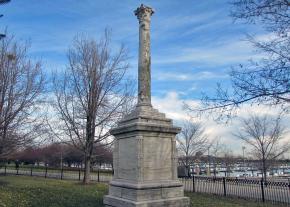Time to throw out that gift from the fascists
, author of People Wasn't Made to Burn: A True Story of Race, Murder, and Justice in Chicago, points out that statues commemorating far-right racists aren't confined to the South--and offers some thoughts on how to dispose of one in his hometown of Chicago.
IN EARLY July, Chicago Mayor Rahm Emanuel boasted in the New York Times that our city's public transit system was far superior and popular compared to New York's increasingly dangerous one, in an op-ed article called "In Chicago, the Trains Actually Run on Time."
I chuckled when I read the headline because I couldn't tell if the mayor's media team suggested the title, oblivious to its connection to Benito Mussolini, the former fascist dictator of Italy--or if maybe the Times headline writers were tweaking Emanuel?
A friend of mine, soon after seeing it online, christened the mayor "Rahmolini!"
While that episode might be a humorous moment of historical amnesia, there's no excuse for Chicago's more sinister ties to Italian fascism: the Balbo Monument and Balbo Drive, named after Italo Balbo, Mussolini's right-hand man and his one-time heir apparent.
Yes, we have a fascist monument in Chicago. If you don't believe me, here's what inscribed on the base of the monument:
This column, twenty centuries old, was erected on the beach of Ostia, the port of Imperial Rome, to watch over the fortunes and victories of the Roman triremes. Fascist Italy, with the sponsorship of Benito Mussolini, presents to Chicago a symbol and memorial in honor of the Atlantic Squadron led by Balbo, which with Roman daring, flew across the ocean in the 11th year of the Fascist era.

Typically vainglorious in tone, you can almost hear Mussolini's bombastic voice emanating from the marble. Balbo famously led a squadron of Italian military aircraft to Chicago's World Fair of 1933. His trek was closely followed by the world's press, and he was greeted with great fanfare when he arrived in Chicago.
Mussolini's gift, the Roman column on top of the inscribed marble base, was presented to the city the following year, and has stood for eight decades behind Soldier Field stadium, where the Chicago Bears play, near the Lake Michigan shoreline. I ride my bike past it all the time.
BALBO, AS you can guess, was no minor leaguer in the Italian fascist regime. "Balbo was one of the most violent warlords of the fascist movement and had a pivotal role in bringing Benito Mussolini to power," Loyola University professor Anthony Cardoza told Chicago magazine back in 2008, during one of the periodic rediscoveries of Chicago's unique ties to Italian fascism.
Balbo specialized in crushing Mussolini's enemies, whether communist, socialist or liberal. He governed Mussolini's Libyan colony, fought his wars in Ethiopia and commanded Italian military forces in North Africa at the outbreak of the Second World War. He died in the early months of the war from friendly fire while his plane was landing in Tobruk.
But it was as Mussolini's airborne ambassador that the world came to know him. "Everywhere he flew," his biographer Claudio Segre wrote, "from Latin America to the Soviet Union, from Chicago to Berlin, he presented himself as an emissary of Mussolini's Italy, of the new fascist generation."
To put it bluntly: Balbo was a handsome, charming snake. Even the New York Times was seduced by him. "Bluff yet suave, fearless and supple, he was not the type to pass unnoticed anywhere," the Times enthused.
Segre warned his readers in Italo Balbo: A Fascist Life, "In these pages, the reader may at times succumb to Balbo's charm and fascination as I did. Nevertheless, I have not forgotten the real nature of the regime that Balbo promoted and served so well--and I hope the reader does not either."
That regime, according to historian J.B. Bosworth, "at a minimum count, with its repressive policies at home and its aggressive war in its empire and in Europe, must bear the responsibility for the premature death of a million people. It holds a prominent place in the black book of human misdeeds in the twentieth century."
Why does Chicago still have a monument and a street named after one of the creators of such a monstrous regime?
After the murderous events in Charlottesville, Virginia, we need to confront the fascist threat today, but we still need to clean up the American past. It's long past time for the Balbo monument to go.


